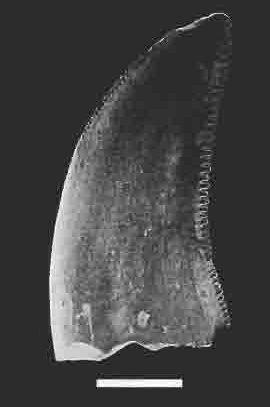Velociraptor
Velociraptor (Velociraptor mongoliensis), whose name means "swift seizer" in Latin, is a genus of dromaeosaurid theropod dinosaur that lived approximately 75 to 71 million years ago during the latter part of the Cretaceous Period. Discovered in the Gobi Desert of Mongolia, Velociraptor is one of the best-known dinosaurs, thanks in part to its prominent role in popular culture, most notably the Jurassic Park series. Despite its depiction in media as a large, cunning predator, Velociraptor was actually relatively small, with adults measuring up to 2.07 meters (6.8 feet) in length and weighing up to 15 kilograms (33 pounds).
Description
Velociraptor was a bipedal, feathered carnivore with a long, curved, sickle-shaped claw on each hind foot, which it used to tackle and incapacitate prey. Its skull, which was long and low, contained up to 80 teeth, varying in size from front to back. The dinosaur's arms were long and it had three curved claws on each hand. The presence of feathers is supported by fossil evidence, including a well-preserved Velociraptor specimen found in Mongolia that showed quill knobs, indicating where feathers would have been attached to the arm.
Discovery and Species
The first Velociraptor fossil was discovered in 1923 by the American Museum of Natural History's expedition to the Gobi Desert. The genus currently includes two recognized species: the type species V. mongoliensis and V. osmolskae, named in 2008 for Polish paleontologist Halszka Osmólska. The discovery of Velociraptor and its relatives has contributed significantly to our understanding of the evolution of birds and the relationship between birds and dinosaurs.
Paleobiology
Studies of Velociraptor's morphology and biomechanics have allowed scientists to make educated guesses about its behavior. It is believed to have been a highly agile predator, capable of leaping and using its sickle claw as a weapon to deliver fatal wounds to its prey. Analysis of skull mechanics suggests Velociraptor could deliver powerful bites, making it capable of handling struggling prey. The structure of its inner ear indicates that it had a keen sense of balance, aiding in its agility and hunting prowess.
Paleoecology
Velociraptor inhabited a semi-arid environment with sand dunes interspersed with oases and stream beds, sharing its habitat with other dinosaurs such as Protoceratops, Oviraptor, and Saurornithoides. The discovery of a Velociraptor specimen locked in combat with a Protoceratops provides direct evidence of its predatory behavior and also suggests that Velociraptor may have hunted in packs to take down larger prey.
In Popular Culture
Velociraptor gained widespread popularity through its depiction in the Jurassic Park movies, where it was portrayed as a large, intelligent, and social predator. Although this portrayal is exaggerated compared to the known scientific evidence, it has cemented Velociraptor's status as one of the most iconic dinosaurs in popular culture.
See Also
Transform your life with W8MD's budget GLP-1 injections from $125.
W8MD offers a medical weight loss program to lose weight in Philadelphia. Our physician-supervised medical weight loss provides:
- Most insurances accepted or discounted self-pay rates. We will obtain insurance prior authorizations if needed.
- Generic GLP1 weight loss injections from $125 for the starting dose.
- Also offer prescription weight loss medications including Phentermine, Qsymia, Diethylpropion, Contrave etc.
NYC weight loss doctor appointments
Start your NYC weight loss journey today at our NYC medical weight loss and Philadelphia medical weight loss clinics.
- Call 718-946-5500 to lose weight in NYC or for medical weight loss in Philadelphia 215-676-2334.
- Tags:NYC medical weight loss, Philadelphia lose weight Zepbound NYC, Budget GLP1 weight loss injections, Wegovy Philadelphia, Wegovy NYC, Philadelphia medical weight loss, Brookly weight loss and Wegovy NYC
|
WikiMD's Wellness Encyclopedia |
| Let Food Be Thy Medicine Medicine Thy Food - Hippocrates |
Medical Disclaimer: WikiMD is not a substitute for professional medical advice. The information on WikiMD is provided as an information resource only, may be incorrect, outdated or misleading, and is not to be used or relied on for any diagnostic or treatment purposes. Please consult your health care provider before making any healthcare decisions or for guidance about a specific medical condition. WikiMD expressly disclaims responsibility, and shall have no liability, for any damages, loss, injury, or liability whatsoever suffered as a result of your reliance on the information contained in this site. By visiting this site you agree to the foregoing terms and conditions, which may from time to time be changed or supplemented by WikiMD. If you do not agree to the foregoing terms and conditions, you should not enter or use this site. See full disclaimer.
Credits:Most images are courtesy of Wikimedia commons, and templates, categories Wikipedia, licensed under CC BY SA or similar.
Contributors: Prab R. Tumpati, MD






